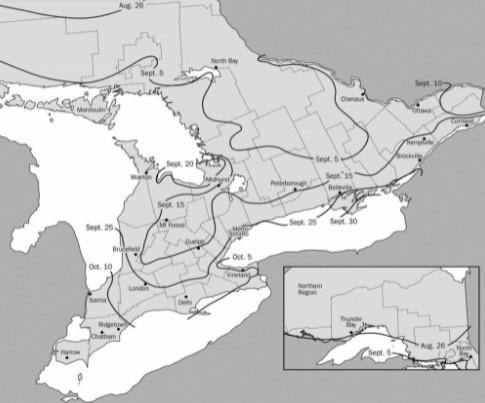Best Management Practices for Late Planted Winter Wheat
With many soybean fields across the countryside just starting to change colour, harvest is not likely to begin anytime soon. A cool, wet spring delayed soybean planting in much of the province and cooler temperatures in August and September have pushed harvest back this fall compared to the last two years. As a result, growers are wondering whether or not they will be able to get winter wheat planted at an optimum time.
With winter wheat having huge benefits to a cropping system (an additional 10 bu/ac to the following corn crop and an additional 5 bu/ac to the following soybean crop) growers are encouraged to keep winter wheat in the rotation this fall if possible. Delayed planting can result in lower yields so being diligent this fall with our best management practices for establishing the winter wheat crop will be very important to reduce the risk of significant yield loss.
Crop Rotation
Although the soybean crop may be delayed it is still important to follow a good crop rotation to get the greatest yield benefits. If planting after soybeans is not possible, plant winter wheat after other crops such as edible beans, peas or canola. If planting after silage corn, be sure to implement best management practices for fusarium head blight by selecting a variety that is moderately resistant to fusarium and apply a fungicide at the T3 timing. Do not plant wheat after wheat as there are a number of disease issues including fusarium and take all that can negatively impact yield.
Variety Selection
When delayed planting is likely, select varieties with good winter survival. Delayed planting can result in reduced root development and less tillers in the fall thereby increasing the risk of winterkill. 2017 data on winter survival, yield, disease resistance, lodging, etc. for winter wheat varieties grown in Ontario is now available on the Ontario Cereal Crop Committee website at GoCereals.ca. When looking at the data, select varieties that perform well in your area across a number of sites and years. Use high quality seed with excellent germination as well as a seed treatment to help protect against seedling diseases.
Plant Population
The optimum date to seed winter wheat varies across the province. In southwestern Ontario the optimum date is mid-October, south-central Ontario mid-late September, central Ontario mid-September and eastern Ontario early September (Figure 1). At the optimum timing, winter wheat should be seeded at 1.4 – 1.5 million seeds/acre. This can very slightly depending on the variety so check the label for the particular variety you want to grow. When planting is delayed, reduced tillering needs to be compensated for. Therefore, you should increase the seeding rate by 200,000 seeds/week to a maximum of 2.2 million seeds/acre for every week you delay planting.

Figure 1: Optimum date to seed winter wheat across Ontario, OMAFRA Pub 811.
Starter Fertilizer
Winter wheat is very responsive to starter fertilizer and phosphorus fertilization in particular. It provides nutrients for early growth and promotes root development. Past Ontario research has shown that seed-placed starter fertilizer increases yields, on average, by 7.5 bu/ac (Table 1). Starter fertilizer becomes even more critical when winter wheat planting is delayed as it also improves winter survival and crop uniformity the following spring. Without starter fertilizer the winter wheat crop may be uneven resulting in challenges with disease management, specifically when trying to manage fusarium head blight. Apply starter fertilizer to the winter wheat crop based on an accredited Ontario soil test.
Table 1: Yield Response to Starter Fertilizer – Johnson, McClure, Janovicek 2010–2013 – OMAFRA Pub 811.
| Fertilizer (In furrow) | P Applied | Yield Increase over Check |
| Soil Test P 6-13 ppm1 (10 sites ) | Soil Test P 13-21 ppm1 (9 sites) | Soil Test P 21-56 ppm1 (9 sites) |
| Liquid 6-24-6 |
| 10 US gal/acre | 27lb P2O5/ac | 12.0% | 6.2% | 3.3% |
| 5 US gal/acre | 12 lb P2O5/ac | 9.7% | 2.7% | 1.8% |
| 2.5 US gal/acre | 7 lb P2O5/ac | 6.3% | 2.9% | 0.9% |
| Dry 7-34-20 |
| 50 lb/ac | 17 lb P2O5/ac | 10.9% | 4.7% | 3.5% |
| 150 lb/ac | 52 lb P2O5/ac | 17.3% | 6.2% | 4.8% |
| 200 lb/ac | 68 lb P2O5/ac | 12% | 3.5% | 4.6% |
| Average Check Yield | 79 bu/ac | 88.5 bu/ac | 89 bu/ac |
1Plant available P based on accredited Ontario soil test.
Table 2. September 6 – 12, 2017 Weather Data

Source: FieldCropNews